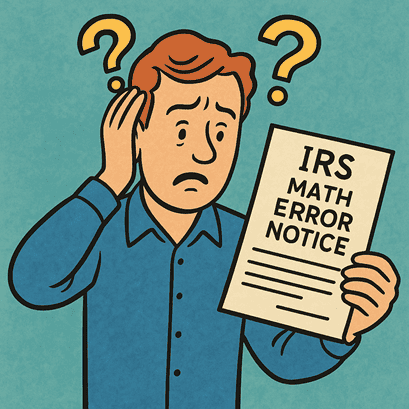H.R. 998 – Internal Revenue Service Math and Taxpayer Help Act
A new bill to make IRS “math error” notices cleaner and more fair.
1. Legislative Status
- Introduced: February 5, 2025, by Rep. Randy Feenstra (R-IA).
Bill text on Congress.gov › - Passed House: Unanimously, following a 43-0 bipartisan vote in the Ways & Means Committee.
Committee tally sheet › - Passed Senate: October 20, 2025.
Senate action record › - Support: Broadly bipartisan, no significant public opposition.
The AICPA explicitly endorsed the bill in a March 31, 2025 letter of support › and in a press release following committee approval ›.
2. Next Step: Presidential Signature
The bill now awaits the President’s signature to become law.
Given its bipartisan support and non-controversial nature, a veto is not expected, but we cannot predict exactly when POTUS will sign it into law. Once enacted, the law will take effect 12 months after the date of enactment.
3. Why It Matters: Reforming “Math Error” Notices
IRS “math error” notices are notorious for having little to do with actual math.
Instead, they often deny credits or make adjustments that raise your tax bill or reduce your refund — with no clear explanation.
The current notices usually include vague boilerplate language, leaving taxpayers confused about what the IRS changed and why. The IRS takes unilateral action to alter your return, often without detailing its reasoning or providing straightforward instructions for appeal.
Example: The Stein Family
Imagine Jonathon and Jane Stein, who welcomed baby Sam on November 1, 2024 (mazal tov!). They quickly registered Sam’s birth at the U.S. embassy in Jerusalem and applied for his SSN. They also filed an automatic extension to October 15, 2025, and the SSN was issued July 1, 2025. They filed their 2024 Form 1040 on October 1, 2025, claiming Sam for the Child Tax Credit.
But in November 2025 they received an IRS “math error” notice disallowing the credit — without explaining the issue. In practice, resolving this requires multiple calls, written memos, and months of waiting, all before even understanding why the IRS made the change. Why did the IRS make this adjustment? While the PATH Act of 2015 clearly allows for extensions to determine the timeliness of SSN issuance, IRS policy is to deny all SSN’s issued after April 15 of the tax year and then leave it to the taxpayers (or their representative) to make the appropriate and necessary appeals to claim their lawful credit.
Note: this example disregards the added leniencies involved with disaster relief available to residents of Israel over the past couple of years. See Coping with the War, Coping with Taxes for full details.
For more on resolving IRS conflicts, see our guide:
IRS Conflict Resolution – How to Fix Common Tax Problems ›
4. What H.R. 998 Changes
The bill amends IRC § 6213(b)(1) to require that every math-error notice include:
- The type of error, the specific line on the return, and the relevant code section.
- An itemized computation showing how income, deductions, and credits were adjusted.
- The phone number for the automated transcript service.
- The deadline for requesting abatement, printed in bold, 14-point type next to the mailing address.
- A pilot program for sending notices by certified or registered mail, with a required report to Congress.
5. Outlook
We expect this bill to become law within months, with implementation in 2026.
It should bring long-overdue transparency to one of the most confusing areas of IRS correspondence — a welcome development for taxpayers and practitioners alike.
The proof, of course, will be in the implementation: whether IRS systems and staff can consistently deliver the new, detailed notices.
⚖️ Disclaimer
This article is provided for general informational purposes only and should not be construed as legal, accounting, or tax advice. It might contain factual errors. Every taxpayer’s situation is unique, and laws or IRS procedures may change after publication. You should consult a qualified U.S. tax professional before taking any action based on this information. Reading this post or contacting our office does not create a client-advisor relationship.

